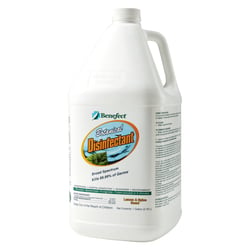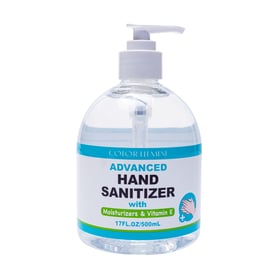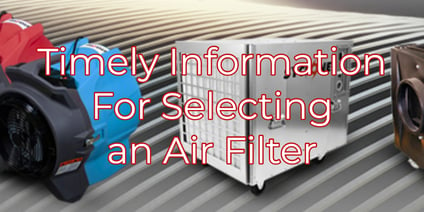Primer on Sanitizers and Disinfectants for the Water Damage, Restoration, and Cleaning Industry
The use of antimicrobials or a biocide on any particular job may or may not be advisable. The technician will have to use good judgment to weigh potential benefits and potential risks. Biocides may not be required on a Category 1 water loss. They may have a benefit on a Category 2 or 3 water loss.
Antimicrobial is the broad term used to describe a substance that works against micro-organisms to control or stop their growth. Antimicrobials are built into some products to reduce micro-organisms on the surface.
Biocide is a combination of “bio” meaning life and “cide” meaning to kill. Thus a biocide is a compound that kills a wide spectrum of living organisms. Getting more specific, a fungicide kills fungi (including molds), a bactericide kills bacteria and a virucide deactivates/destroys viruses.
Before applying a biocide, the restorer should get the informed consent of the building owner. All occupants, including animals, should leave the building before the use of a biocide.
There are various levels of biocidal activity. A sterilizer kills 100% of all micro-organisms, including fungi, bacteria, viruses, and their spores. This is the highest level of biocidal activity. Sterilizing can be accomplished with steam, heat, or pesticides. However, sterilizers are not practical to use in the cleaning or water damage restoration industries..jpg?width=252&name=My%20Post%20Copy%20(3).jpg)
For a product to be labeled as a disinfectant it must have been tested and approved by a federal regulatory agency such as the EPA for the USA or Health Canada for Canadian products. While antiseptics kill microorganisms on the skin or other living tissue, disinfectants kill disease-causing organisms on inanimate surfaces.
Passing government testing requires that a disinfectant kill the organism(s) that it is being tested against but not necessarily the spores. Testing is done on hard, non-porous surfaces. Because the testing of disinfectants and sanitizers is not done on soft surfaces such as carpet, it is not possible to make claims of disinfecting a soft surface.
Disinfectants must kill or inactivate 99.999% or in some cases 99.9999% of the organisms they are tested against. This level of effectiveness may be called 5 log or 6 log kill rates. To achieve this, a disinfectant can have a dwell time of 10 minutes or longer.
A disinfectant must be given the necessary dwell time to work completely. After being applied, a disinfectant should remain moist for the full dwell time. It should not be wiped off before then. Disinfectants that can pass testing in short periods are more uncommon.
Some disinfectants are tested against only a few specific organisms mandated by the EPA (for example Pseudomonas aeruginosa, staphylococcus aureus, and tuberculosis for intermediate or hospital-grade disinfectants). Others are tested against a wide spectrum of pathogenic (disease-causing) organisms that the manufacturer believes they will work against. The label or additional info on an expanded label or compendium from the manufacturer will indicate which organisms it has proved effective against.
EPA uses the terms “hospital disinfectant” for products to be used where infection control is critical, for example, medical and dental instruments, and public toilet seats. “General purpose” or household disinfectants may be used in homes, and water purifiers.
The EPA only officially defines three descriptive terms for disinfectants.
- Low-level disinfectants are non-tuberculocidal (don’t kill the organism responsible for tuberculosis).
- Intermediate-level disinfectant is tuberculocidal. A hospital-grade disinfectant would need to be tuberculocidal.
- High-level disinfectants are also regulated by the FDA as medical devices. They are not used on environmental surfaces.
There are many undefined descriptions used in marketing disinfectants and sanitizers.
Label directions state what surfaces a product will work on, instruction on how a product should be diluted, and how it should be applied. Always follow label directions. It is a violation of federal law to claim to disinfect or sanitize a surface not specified by label directions. Pay attention to the recommended application methods, as well.
Chemicals with the lowest level of biocidal activity are sanitizers. To be approved by the EPA as a sanitizer, the product must be shown to reduce microbial activity to what is determined to be a safe level. Usually, this is 99.9% of 3 log kill rate. Sanitizers significantly reduce but do not eliminate all micro-organisms. To qualify as sanitizers, a product must act fast. Dwell times of 30 seconds or less are normal.
While no product can make disinfectant claims for carpet, upholstery, or other soft surfaces, there are sanitizers approved for carpet.
Different Types of Biocides/Disinfectants
Hypochlorites
The most common product in this category is sodium hypochlorite or regular laundry bleach. Chlorine bleach is normally sold for laundry use in a solution of 5.25%. Mixing at a ratio of 10 parts water to 1 part bleach yields a .5% solution that can be used to disinfect some hard surfaces.
Because bleach is inexpensive and readily available, the U.S. EPA has recommended a bleach solution for homeowners coping with floods, although there are safety and material concerns when using a bleach solution.
Chlorine bleach will dissolve protein fibers including wool and silk. It can also remove the color from carpet and fabrics. It is corrosive to metals as well as a severe irritant to skin. Chlorine should not be fogged. Chlorine should never be mixed with other cleaning agents, especially acids or ammonia.
Chlorine bleach solutions have limited cleaning ability. There are more effective products for use against a wider spectrum of micro-organisms. For these, and other reasons, hypochlorites are seldom used for professional water damage restoration.
Like many disinfectants and sanitizers, bleach is inactivated by contact with organic matter. For this reason, it is most effective on pre-cleaned surfaces.
Hydrogen peroxide
Hydrogen peroxide is also an oxidizing bleach. Hydrogen peroxide is available in several strengths. The most widely available concentration is 3%. Hydrogen peroxide is corrosive and can remove the color from fabric. This is more likely to occur at higher concentrations.
It has a relatively short shelf life being degraded by heat and sunlight (or any source of UV light). One advantage of hydrogen peroxide is that it breaks down into innocuous water and oxygen.
As with hypochlorites, hydrogen peroxide is inactivated by contact with organic material and should be used on pre-cleaned surfaces.
Due to cost and other reasons mentioned above, hydrogen peroxide is not commonly used as an antimicrobial in the water damage restoration industry.
Alcohol is frequently used as an antiseptic, for example, to assure our skin is free of bacteria before an injection is given. Isopropyl alcohol (AKA isopropanol, rubbing alcohol) or ethyl alcohol are sometimes used as disinfectants. Alcohol is very effective on bacteria but is not an effective disinfectant against mold.
Alcohol must be used at high concentrations, above 60%, to be an effective disinfectant. The diluting effect of water could easily reduce concentrations below the effective level. Also, alcohol is inactivated by organic matter.
Alcohol is highly flammable. The volume of alcohol required to effectively disinfect even a minor water damage situation would make its use dangerous. Alcohol may be added as an ingredient in a formulated disinfectant product to boost its effectiveness.
Glutaraldehyde
The advantages of glutaraldehyde include the fact that it is not inactivated by organic waste, is highly effective and spores, as well as organisms and, is non-corrosive. A major disadvantage is that glutaraldehyde is highly toxic. It can irritate the nose, eyes, throat, and lungs. It may also cause dizziness and headaches. If glutaraldehyde is employed be sure to use proper personal protective equipment along with good ventilation.
Glutaraldehyde is not commonly used in our industry at full disinfectant strength, but it may be included as an ingredient in some sanitizers or disinfectants.
Iodophors
The combination of iodine and a surfactant that allows it to be dissolved in water is known as an iodophor. When mixed with water it releases free iodine.
A contact time of 2 minutes or longer is required. Like many disinfectants, iodophors are also inactivated in the presence of organic material.
The iodine component can leave brownish-orange stains on plastics, including synthetic carpet fibers, and other material.
Phenolics
Phenol is the simplest of a group of related molecules that are used as disinfectants. It is effective at concentrations as low as .5%. Insufficient concentration or quantity, phenol will irritate the skin. Phenol can be severely irritating to the respiratory system. When applied with a sprayer, use a larger orifice to produce bigger droplets rather than atomizing or fogging. This helps reduce the possibility of inhaling compounds containing phenol.
The advantages of phenol products are residual activity and relatively low cost. Several disinfectants and sanitizers used in our industry contain phenol.
Quaternary Ammonium Compounds
Often shortened to “quats”, this group of compounds are cationic surfactants. Their ability to act as wetting agents provides some cleaning action while also making the product more effective.
Early quats had limited biocidal activity. Rather than being a single compound, quats are a family of related molecules. Improved “generations” of quats have been developed that have a broader spectrum of activity, are more effective and safer to use than the simplest quats.
As with most of the disinfectants, organic material inactivates their activity. For this reason, they are more effective on precleaned surfaces. They have very limited usefulness in situations with sewage or black water contamination. Quats work at dilutions under .5%. They are inexpensive and safer than many disinfectants. However, there is always some toxicity in any product which is intended to kill living organisms.
You may see the term “botanical” used to describe some disinfectants. These are phenolics with the active ingredient from a natural plant source such as thymol from thyme oil (natural oil from the thyme plant). These products have the best safety rating for any disinfectant or sanitizer. There are also synthetic thymol-based products produced in a lab rather than from a plant source. These also have good safety ratings.
by Scott Warrington
Featured Products

Benefect, Antimicrobial, Botanical Decon 30 Cleaner & Disinfectant, 1 Gallon
Enjoyed reading this post? Read the following articles:




